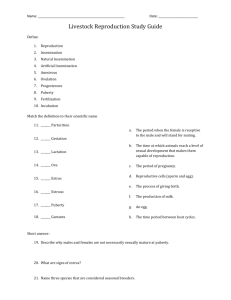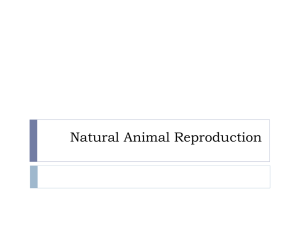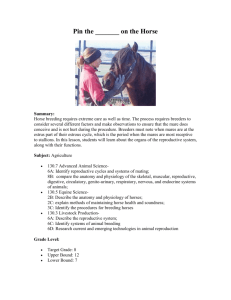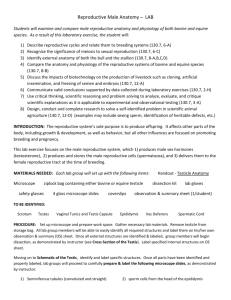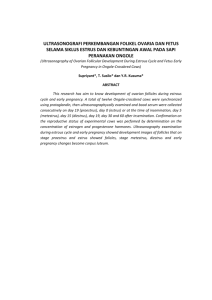CLF243
advertisement
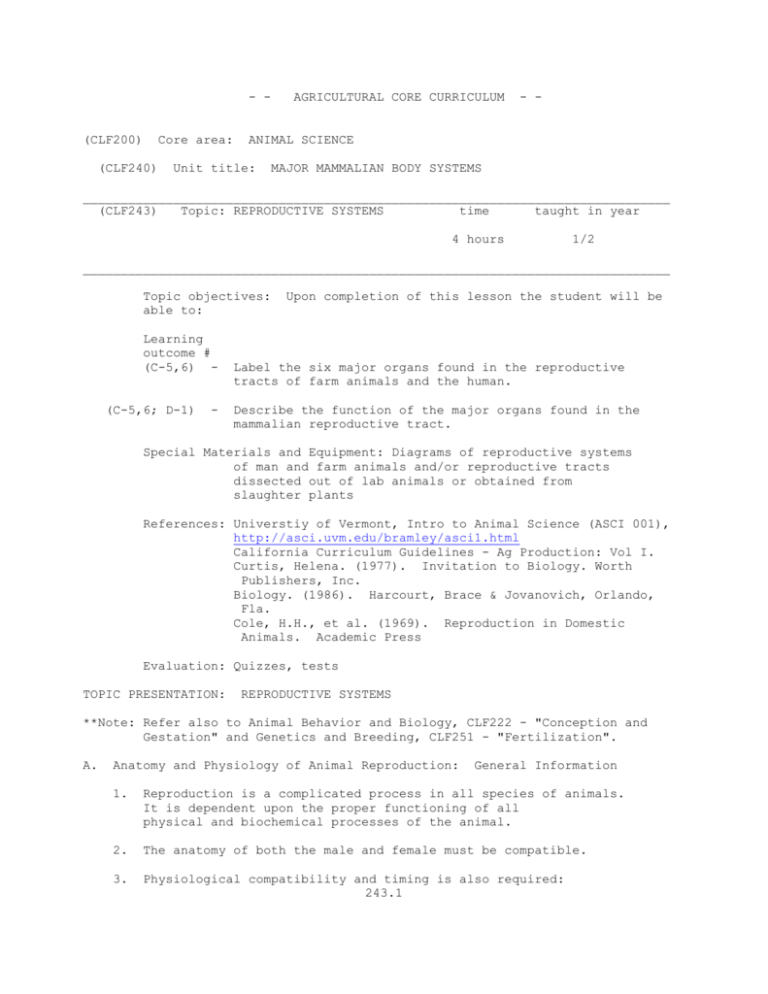
- (CLF200) Core area: (CLF240) AGRICULTURAL CORE CURRICULUM - - ANIMAL SCIENCE Unit title: MAJOR MAMMALIAN BODY SYSTEMS ______________________________________________________________________________ (CLF243) Topic: REPRODUCTIVE SYSTEMS time taught in year 4 hours 1/2 ______________________________________________________________________________ Topic objectives: able to: Learning outcome # (C-5,6) (C-5,6; D-1) - Upon completion of this lesson the student will be Label the six major organs found in the reproductive tracts of farm animals and the human. Describe the function of the major organs found in the mammalian reproductive tract. Special Materials and Equipment: Diagrams of reproductive systems of man and farm animals and/or reproductive tracts dissected out of lab animals or obtained from slaughter plants References: Universtiy of Vermont, Intro to Animal Science (ASCI 001), http://asci.uvm.edu/bramley/asci1.html California Curriculum Guidelines - Ag Production: Vol I. Curtis, Helena. (1977). Invitation to Biology. Worth Publishers, Inc. Biology. (1986). Harcourt, Brace & Jovanovich, Orlando, Fla. Cole, H.H., et al. (1969). Reproduction in Domestic Animals. Academic Press Evaluation: Quizzes, tests TOPIC PRESENTATION: REPRODUCTIVE SYSTEMS **Note: Refer also to Animal Behavior and Biology, CLF222 - "Conception and Gestation" and Genetics and Breeding, CLF251 - "Fertilization". A. Anatomy and Physiology of Animal Reproduction: General Information 1. Reproduction is a complicated process in all species of animals. It is dependent upon the proper functioning of all physical and biochemical processes of the animal. 2. The anatomy of both the male and female must be compatible. 3. Physiological compatibility and timing is also required: 243.1 B. a. If two animals of different breeds or subspecies copulate, their systems (and genetic makeup) must be similar enough for the sperm and ovum to unite (fertilization) and begin cell division; b. the female must be willing to accept the male (in heat); and c. the ovum must be mature and ready to be fertilized (i.e., ovulation must have occurred). 4. The above are dependent on the proper function of many organs. 5. Any abnormality in the anatomy or physiology of the reproductive tract results in lower fertility or complete sterility of the animal. __________________________________________________________ ACTIVITIY: As the students take notes on the following information, provide each with a complete diagram of both male and female systems. As the lesson progresses, have them id the parts on the handout provided __________________________________________________________ Anatomy of the male reproductive tracts. 1. The male's role is less complex than the female's. 2. The male's role is to produce large numbers of viable male sex cells called spermatozoa. 3. The male contributes 1/2 of the chromosomes to each of his offspring. 4. After mating, the role of the male is over. 5. The male reproductive organs in the various mammalian species are similar in form and function. 6. The testes or testicles in the male are the primary sex organs and are held in a sac called the scrotum. a. They produce spermatozoa and the male hormone testosterone. b. Each male normally carries two testicles in the scrotum. c. The scrotum functions as a heat regulating mechanism. 1) 7. 4-5 degrees below body temperature is essential for spermatogenesis - the growth and maturation of the sperm. In some farm animals only one or neither testicle may drop out of the body cavity into the scrotum. a. A "monorchid" has one fertile testicle (ie - on has dropped and remains somewhat fertile. 243.2 1) b. 8. 9. Although the testicle in the body does not produce viable spermatozoa, it does produce testosterone. If both testicles remain in the body cavity the animal is termed a "cryptorchid" and is sterile. Castration of the male consists of removing both testicles. a. It is usually done early in life. b. Castrated males do not develop a sex drive and tend to gain weight quicker (for slaughter). c. When monorchids are castrated only the dropped testicle is taken and the animal retains its sex drive, but is infertile. (This is a very undesirable animal from a management standpoint.) Each testicle is made of lobules containing long tubes containing the spermatozoa in all stages of development a. The sperm producing cells are called "spermatogonia." 1) It is believed the cells surrounding the spermatogonia called "Sertoli" cells serve a protective and nutritional role for the germ cells (spermatogonia or sex cells). a) b. 10. 11. The Sertoli cells are located in microscopic tubes in the testes called "seminiferous tubules." In the testes the spermatozoa do not possess motility (ability to move under their own power) and are not capable of fertilization. The epididymis is a long continuous tube consisting of a head, body, and tail a. The head portion is connected to the testes. b. The tail appears as an enlargement on the ventral portion of the testes in the scrotum. c. The tail is the storage for the spermatozoa (200 billion at a time). d. Spermatozoa mature as they migrate through the epididymis. e. The tail of the epididymis widens into a larger, longer tube, the vas deferens, leading to the urethra. The vas deferens leads from the tail of the epididymis into the urethra. a. If a section of this is removed the male cannot reproduce (vasectomy). 243.3 12. The urethra begins at the opening of the bladder and is continuous with the penis. a. In mature bulls, the posterior portion of the urethra is S-shaped. b. This is known as the "sigmoid flexure." c. It extends the penis outside the body and into the vaginal cavity of the female so that the semen can be deposited. d. If the sigmoid flexure does not work you have the equivalent of a sterile male. 13. "Accessory sex glands" include the a. prostate gland; b. two seminal vesicles; and c. two Cowper's. 14. The function of the accessory sex glands is to provide an essential medium (fluid environment) for the transport of the sperm from the testes to the vagina. a. The medium 1. adds volume; 2. provides nutrients for the sperm; 3. cleans and flushes out the urinary tract; and 4. in some species, makes a "plug" to hold the semen in the vagina. C. Anatomy of the Female Reproductive Tract 1. The female plays a more important role in reproduction, since she: a. not only provides 1/2 of the chromosomes of the young, b. but also nourishes the young in her uterus and after birth until weaning. 2. The female tract consists of the vulva, vagina, cervix, uterus, uterine horns, Fallopian tubes, and ovaries. a. The vulva is the exterior portion of the reproductive tract. b. The vagina is the region between the vulva and the cervix. 243.4 c. d. 1) In cows and ewes, semen is deposited here. 2) In mares and sows, the semen is deposited in the cervix. The cervix or mouth of the womb is the opening into the uterus through which sperm must pass to fertilize the egg. 1) At birth, the cervix stretches enough for the newborn to pass through; in humans, this process of "dilation" is usually the most painful part of the birth process. 2) To help prevent entry of potentially harmful infections when pregnancy occurs, the cervix becomes blocked with a mucus plug. The uterine horns are the two branches of the uterus. 1) e. The Fallopian tubes or oviducts are found at the anterior end of each uterine horn. 1) f. D. The forward end of each horn leads to a small convoluted tube, called the Fallopian tube. They are lined with microscopic cilia that assist the ovum (egg) as it travels down toward the uterine horn. The normal female has two ovaries located in close proximity to each Fallopian tube. 1) Each ovary possesses a large number of female reproductive cells (ova) in all stages of development. 2) Unlike the male who produces all sperm after the onset of puberty (sexual maturity), each female possesses all of her potential ova at the time of birth. 3) Relatively few reach maturity and are ovulated. 4) If fertilization does not occur after ovulation, the ovum is gradually reabsorbed. Reproduction in males (See also Supplemental Handout #1 in CLF247.) 1. After sexual maturity of the male, sperm production is continuous under most conditions. 2. Testosterone is the primary male sex hormone responsible for a. the growth, development, and secretory activity of the accessory glands; b. the survival of spermatozoa; and c. the secondary sex characteristics, crest, male voice, and sex drive. 243.5 13. "Semen" is the term used for the fluid ejaculated by the male for reproductive purposes. It is made up of: a. fluid from the many accessory glands; and b. sperm cells. 14. The amount spermatozoa and total volume of seminal fluid varies in each species. 15. Spermatozoa may be stored in the epididymis for several days. a. In the female, sperm will survive for 24-96 hours b. If frozen for artificial insemination, it will last many years. E. Reproduction in females. (See also Supplemental Handout #1 in CLF247.) 1. Most farm animals reach sexual maturity in 4 (sow) to 24 (mare) months; at this time the "follicles" begin to develop, then: a. the female comes in heat (estrus); b. the follicle containing the maturing ovum bursts; and c. the egg is ovulated and travels down the oviducts to a point at which it can be fertilized by the sperm. 2. The age of puberty not only varies between species, but also among individuals within the same species. 3. Puberty is brought on by hormone secretions, primarily of estrogen. F. Estrus and the estrous cycle 1. Estrus in farm animals is the time the female has or is about to ovulate and is "receptive" to the male. 2. The first estrous cycle begins at puberty and is the interval between two estrous periods while the animal is not pregnant. (SPELLING NOTE: It is spelled ESTROUS for the cycle and ESTRUS for the time of receptivity.) 3. There are four different phases of the estrous cycle a. Proestrus, the phase just before estrus: 1. the vaginal wall thickens in preparation to receive the fertilized egg; and 2. the ovary is about to release the ovum. b. Estrus is the time for acceptance of the male and normally coincides approximately with ovulation. 243.6 c. d. Metestrus is: 1) the period immediately following estrus; 2) if conception has taken place the uterus prepares for pregnancy; and 3) the fertilized egg will settle and attach there. Diestrus occurs between metestrus and proestrus and is the longest period of the cycle _____________________________________________________________ ACTIVITY: Have the students complete Supplemental Worksheet #3 using notes or Supplemental Worksheet #2 as a reference An alternative would be to have the students plot out the estrous cycles on a timeline so that the sow, ewe, cow, mare, and woman's cycles can be compared Provide the students with Supplemental Worksheet #2 as a reference _____________________________________________________________ 4. Non-pregnant females normally express both inward and outward signs of heat throughout the year. These include a. noise and aggressive behavior; b. swelling of the external portions of the reproductive tract; and c. color change of the vaginal wall. 5. Estrous cycles stop after conception. 6. Estrous cycles begin again soon after parturition (birth), in a. sows, one to five days post-partum; b. mare, five to ten days post; c. cows, thirty to sixty days post; and d. ewes are seasonal breeders ____________________________________________________________ ACTIVITY: If not completed above provide copies of the reproductive systems found in Supplemental Worksheet #1: Comparative Anatomy of Reproductive Tracts". Have students identify all organs listed. _____________________________________________________________ 243.7 Supplemental Worksheet #1: Reproductive Systems Comparative Anatomy of Reproductive TRACTS REPRODUCTIVE TRACT OF A MAN 1. 2. 3. 4. 5. 6. 7. 8. 9. Prostate Cowper's Gland Bladder Penis Vas deferens Scrotum Urethra Epididymis Testis 1. 2. 3. 4. 5. 6. 7. 8. 9. 10. 11. 12. REPRODUCTIVE TRACT OF A WOMAN 1. 2. 3. 4. 5. 6. 7. REPRODUCTIVE TRACT OF A BULL Free End of Penis Epididymis Scrotum Testis Vas deferens Urethra Sigmoid Flexure of Penis Retractor Penis Muscle Prostate Gland Seminal Vesicles Bladder Cowper's Gland REPRODUCTIVE TRACT OF A COW Bladder Ovary Oviduct Uterus Cervix Vagina Urethra 1. 2. 3. 4. 5. 6. 7. Uterus Bladder Vagina Rectum Ovary Oviduct Cervix REPRODUCTIVE TRACT OF A FEMALE FOWL 1. 2. 3. 4. 5. 6. 7. 8. 9. 10. 11. Ovary Small Ova Neck of Infundibulum Albumen-secreting Region Isthmus Uterus Cloaca Vagina Infundibulum Ostium Mature Ovum 243.8 Supplemental Worksheet #2: Reproductive Systems PUBERTY, ESTROUS, AND OVULATION IN FARM ANIMAL*** (***Note that exact numbers will vary from resource to resource.) The chart provides the average or range in: age at puberty, weight at puberty, duration of estrus, length of estrous cycle, time of ovulation and the best time to breed. Cow Ewe Sow Mare -------------------------------------------------------Age of puberty (months) Weight at puberty (lbs) Type of Cycle 4-8 7-8 5-8 350-600 60-75 150-250 Polyestrus (all year) Seasonally Polyestrus Polyestrus (all year) Estrous Cycle (ave.) 21 days (range) 18-21 days 17 days 14-19 days Duration of (ave.) estrus or (range) "heat" 18 hrs 10-24 hrs --30-36 hrs Time of Ovulation 10-12 hrs after end near end of heat of heat Best opportunity for fertilization mid heat to shortly after end of heat 21 days 20-22 days --2-3 days 36 hrs. after beginning of heat "little "little significance" significance" (during heat) (during heat) 12-24 Varies with breed Seasonally Polyestrus 22 days very variable 6 days 2-11 days 1-2 days before end of heat Every other day beginning 2nd day heat - - - - - - - - - - - - - - - - - - - - - - - - - - - - - - - - - - - - - woman --------------Age of puberty 8-13 Years - Weight at puberty (lbs) Type of Cycle Estrous Cycle (ave.) (range) Time of ovulation 95-140 Polyestrus (all year) 28 days 22-36 days about 10 days after menstruation 243.9 Supplemental Worksheet #3 Name_______________________________ Date_______________________________ Complete the following: Puberty, Estrus, Ovulation and Gestation in Farm Animals Cow | Ewe | Sow | Mare ______________________________________________________________________________ | | | Age of puberty | | | (months) | | | | | | ______________________________________________________________________________ | | | Weight at puberty | | | (pounds) | | | | | | ______________________________________________________________________________ | | | Duration of estrus | | | (average) | | | | | | ______________________________________________________________________________ | | | Time between estrus | | | periods (ave.) | | | | | | ______________________________________________________________________________ | | | Time of ovulation | | | (average) | | | | | | ______________________________________________________________________________ | | | Best time to breed | | | | | | | | | ______________________________________________________________________________ | | | Gestation length | | | | | | | | | ______________________________________________________________________________ 243.10

